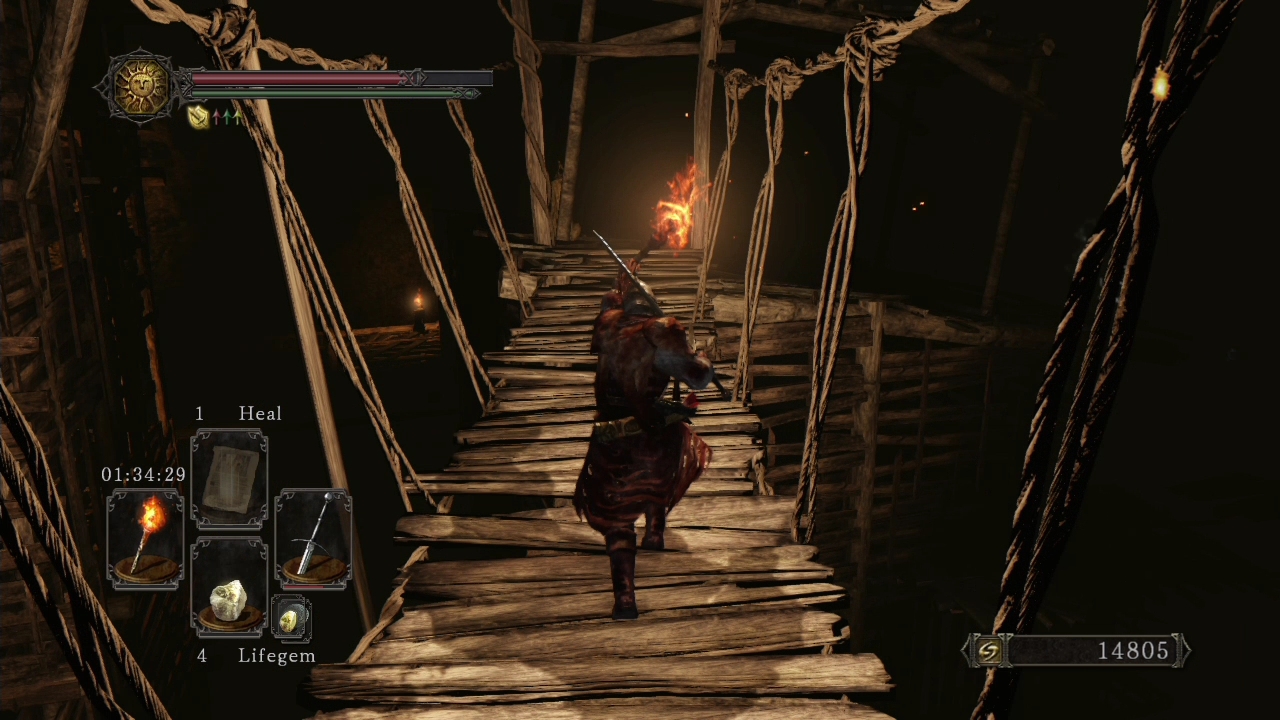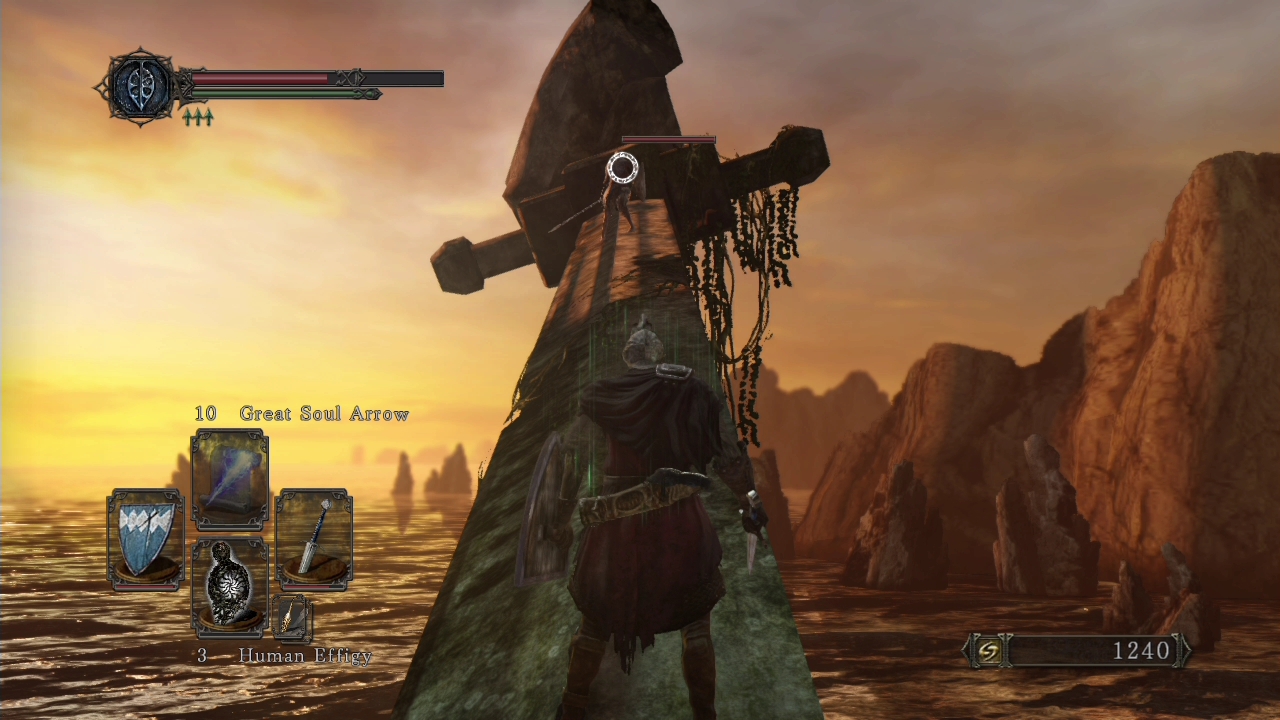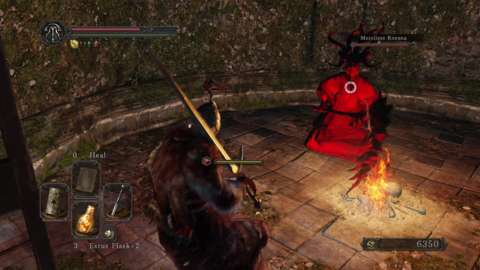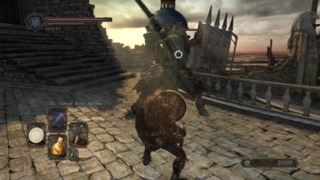If you were disappointed by the less-than-exemplary PC port of the original Dark Souls, you'll be glad to know that Dark Souls II for the PC fares far better, featuring graphical settings and resolution options that befit a proper PC game. Otherwise, Dark Souls II for the PC looks similar to its console counterparts, and its mouse and keyboard controls are comfortable and intuitive enough to make the game a good bet for PC players that don't own gamepads. All told, Dark Souls II is every bit the same superb game that appeared on console last month, and deserves respect for its diverse world and nail-biting challenge. - KV, 4/24/2014 15:00 PDT
How much of your humanity are you willing to give up for even the slightest chance of victory?
Dark Souls II asks this question of you at every turn, encouraging you to press onward in spite of imminent death. And with each death, you lose a little of your humanity and become more hollow. Your maximum health slightly diminishes each time as well, eventually sinking to 50 percent of its full value, and yet as each sliver of humanity is sliced away, you heed the call to move onward. Eventually, you overcome the obstacle that stood between you and victory--that quartet of gargoyles swarming you on a rooftop, that arachnoid demon plunging poisonous pincers into your flesh, that disgusting mound of meat that defies description. You have triumphed! But your gain does not come without sacrifice. You have sworn, you have gasped, and you have sweated. You have forfeited your own humanity so you might collect the souls of the damned.
Like Dark Souls and Demon's Souls before it, Dark Souls II is not just a fantasy role-playing adventure, but a cloud that hangs heavy over your head whenever you so much as think about it. These modern classics developed by From Software have rightfully earned a reputation for being brutally difficult, but their beauty is derived not solely from difficulty, but also from dread. Dark Souls II is not a survival horror game in the normal sense, but few games can make you this afraid to peer around the corner, while simultaneously curious as to what awaits you there. Death is so very beautiful in this game, for it comes at the hands of amazing beasts and warmongers: hulking armored knights, shimmering otherworldly invaders, and tendrils that rise out of black pools of poison. Sure, each death punctures your heart, but one of Dark Souls II's many gruesome pleasures is discovering new ways to die.

The eerie blackness is front and center as you start up the game and enter the mysterious abode in front of you. Three old crones await you inside and ask you to customize your character and choose a class before venturing into the unknown. Like most of Dark Souls II's characters, these women offer vague advice and refer to events and concepts without filling in the details. The anxiety mounts as you weave in and out of the nearby caverns that fill you in on the basics of movement and combat. This area may teach you the fundamentals, but it also raises a number of questions. What are those odd voices you hear when you stand near the bird's nest that rests on a narrow ledge? What is the significance of the flame sconces scattered about that you are meant to set alight? How do you survive encounters with the monstrous ogres on the beach below that squish you like a measly bug when you draw near?
Welcome to Drangleic, a world that is not quick to whisper its secrets to you, in a game that trusts you to find the answers for yourself.

This introduction is not as soul crushing as the original Dark Souls' opening, but that's just fine, for Dark Souls II offers you an early taste of hope, a feeling that was quite rare in its predecessors. That hope arrives by way of Majula, a gorgeous oasis that's as close to a home as you will find in the game. My first glimpse of Majula was a revelation. As I emerged from the nearby shadows, the glowing sun blinded me, and I stood in awe of the world opening up before me. Whenever the bleakness of Drangleic at large overwhelmed me, I was glad to return to this hub for an emotional refresh.
Majula is more akin to Demon's Souls' Nexus than to Dark Souls' Firelink Shrine. It is your central hub of operations, and while it's mostly devoid of life when you first come upon it, it slowly fills out with the vendors you meet upon your travels, many of whom set up shop there. Your most important contact there, however, is the cloaked woman who allows you to level up in exchange for souls, the game's currency. But even Majula is not immune to mystery. There's an impossibly deep hole in the ground here, one that spells certain death if you fall into it. (Don't let it fool you; the boards that crisscross this passage may look high enough to provide a safe landing, but you will not survive that fall.) What's down there? Surely something valuable must lurk down there. Or something horrifying. You eventually make your way down, but Dark Souls II doesn't tell you when or how that may happen.
Death is so very beautiful in this game, for it comes at the hands of amazing beasts and warmongers: hulking armored knights, shimmering otherworldly invaders, and tendrils that rise out of black pools of poison.
Instead, Dark Souls II trusts you. As in its predecessors, there are no waypoints, and there is no quest log. Instead, you simply head out into Drangleic seeking to light primal bonfires and thus restore some dignity to this decrepit land. The only way to defeat the defiant creatures that guard the bonfires, however, is to grow stronger by murdering enemies and collecting their souls, which you then spend on new levels, new armor, and other trinkets that strengthen your resolve in battle. If you've played the earlier Souls games, you should take to the combat quickly. You feel each swing of your axe, each stab with your spear, and each fireball you lob. Timing is key: every action leaves you vulnerable, so you must pay close attention to the rhythm of your enemies' attacks and strike at the opportune moment. Managing your stamina is also vital to success. Every attack you launch uses up stamina, as does successfully blocking an attack. You can't simply flail about with abandon; this is not that kind of game, and not taking care during every encounter will get you killed.

Not that you shouldn't expect death. Dark Souls II is built around your repeated demise. When that inevitable moment comes, you drop all the souls you were carrying and must retrieve them if you don't want to lose them permanently. You get only one chance to get them back, for dying before you reach them eliminates them from the world forever. Of course, this mechanic is nothing new: it's the same concept that powered both Demon's Souls and Dark Souls, after all. But just as Dark Souls represented a structural change over Demon's Souls, so too does Dark Souls II over its predecessor.
Some of the differences are noticeable early on, though their benefits aren't always immediately clear. I was not sure how I felt about one such change: the limited enemy respawns. Each time you die or rest at a bonfire, the world is refreshed and the standard defeated foes respawn. Or at least, that's how it used to happen. In Dark Souls II, there comes a point when many local enemies don't respawn anymore, allowing you freedom to progress with fewer obstacles in your way. It's true that infinite respawns encouraged grinding, particularly when the enemies you faced dropped important items. But that repetition also instilled a bizarre connection between player and game. I can still clearly remember, for instance, exactly how to progress through Dark Souls' Undead Parish--where each enemy is, what attacks it will use, and what precarious drop-offs I must keep a lookout for. When I first encountered the limited respawn system, I worried that the sequel had lost a vital element that would keep Dark Souls II from commandeering my waking and sleeping thoughts.
How much of your humanity are you willing to give up for even the slightest chance of victory?
As it turns out, I shouldn't have worried. The grinding opportunities are still there, and there are in-game items that force enemies in a given region to begin respawning again (and make them more powerful, to boot). Dark Souls II's hook isn't the endless cycle of enemy death and resurrection, however, but the promise of new and exciting places to explore, and new and exciting foes to face. And that hook is supported by any number of subtle changes to the formula. For example, once you activate a bonfire, you can warp to it from any other bonfire without having to pass through perilous places over and over again. Again, I didn't immediately take to this change, but once I discovered just how vast Drangleic was--it's decidedly bigger than Dark Souls' Lordran--I embraced the structural tweaks.

These changes might not have worked had Dark Souls II not made discovery such a thrill, but with each new area comes a new wondrous vista and a new challenge to overcome. The early forests and ruins are very Dark Souls, but the intricate architecture and carefully planned enemy locations make even familiar-looking environments fresh and unique. The more progress you make, however, the more unusual the settings become, and the more you need to consider new methods of approach. Suddenly, undead freaks are flinging themselves to the ground and exploding, and so you must hasten your rhythm. You walk through an archway and into the thickest fog imaginable, where you cannot lock on to the ghostly shimmers that attack you. Poison rains from the sky, bedeviled urns curse you when you linger near, and anthropomorphic tortoises stop, drop, and roll all over your puny body. Dark Souls II wants to kill you, but the cycle of death and rebirth is worth it if it means finding the royal ring that lets you open that giant door and discover what new and wonderful lands lie beyond it.
Those lands are incredibly striking. Given reports of Dark Souls II's new engine, I was disappointed by the game's lighting, which was flatter than I had hoped, thus rendering my torch less vital for providing dynamic light than it might have otherwise been. But to fixate for too long on this single visual element sells the fantastic art design short. Make your way past Harvest Valley's poisonous pools--and the fantastic monstrosities that fire orbs of darkness at you--and you can only marvel at all of the windmills that lie before you. Of course, this is Drangleic and not the Netherlands; those windmills are not quaint landmarks, but harbingers of disease and death. Then there's Iron Keep, which takes lava levels to a whole new height of fiery doom. There are very occasional frame rate issues that intrude on the grim elegance, but nothing on par with Dark Souls' Blighttown struggles.
Poison rains from the sky, bedeviled urns curse you when you linger near, and walking tortoises stop, drop, and roll all over your puny body.
And so Dark Souls II is hard--but is it harder than the original? No. I certainly did my share of shouting while playing through Dark Souls II, pitting my bastard sword against Drangleic's powerful protectors, but nothing caused me controller-flinging frustration the way Dark Souls' Ornstein and Smough did. Nor did I ever snarl and growl the way I did when making my way through the original game's Sen's Fortress, let alone facing Demon's Souls' red dragon. But don't overestimate any rumors that Dark Souls II isn't a great challenge. Trudging my way through shin-deep water while avoiding nearby mages' magical homing missiles was not easy. I yelled when I slipped into a drop-off while focused on the mean wizards, and cursed when sea dwellers swiped me from behind while I blocked oncoming attacks. And then, finally, when I reached the foggy door that led to a new area, I was able to breathe--at least until I realized there was a gross boss monster behind that door.
I must give credit to Dark Souls II for making combat feel as fair as it does. The Souls games have always given you the tools to succeed, but while playing the newest entry, I was impressed by how it balanced new challenges with subtle ways to help you succeed. Sometimes, the path to success is relatively obvious, like using a lever to dunk baddies in boiling lava, or luring an armored turtle under a blade and watching the makeshift guillotine slice the half-shelled villain in two. Other possibilities are so subtle as to be obtuse, rewarding thorough investigation with an unexpected boon. Is poison complicating a battle against an evil queen? Is darkness inhibiting your ability to lock on to a pouncing behemoth? There might be some help out there, just hidden from view. Dark Souls II trusts you to find it--or if not, to overcome without it.

Just as before, help comes from other players as well as from the game itself. Every Dark Souls II player is intertwined in a comforting web of ambiguous communication. As before, you see the spirits of other players as they journey through their own copies of the grotesque wilderness. You teach them (or mislead them) by forming messages out of predetermined phrases and leaving them on the ground for others to spot. You even teach them with the mere act of dying, leaving a bloodstain that others might touch to witness your ghost reenact the last precious seconds of your life. And if you feel truly cooperative, you can offer your services to other players, who can then summon you in for assistance with a troublesome boss.

You can also hinder other players by invading their worlds, just as before, though certain additions to online play keep battles more dynamic than ever. The notification that you have been invaded is still a stomach-churning event, as is the first sight of the red phantom that represents the other player. But your invader is not necessarily invulnerable to the undead soldiers that populate Drangleic--not if you use a particular item designed to make monsters turn on your human enemies. Luring an invader into a trap--look out for the creature with the scythe!--is an absolute delight, though you need to make sure you have your wits about you: the only thing scarier than seeing your evil intruder is not seeing him.
There's so much more to talk about with Dark Souls II. There is the fantastic stretch near the end of the game that fleshes out the story by involving you in grander battles than you would expect from this series. Then there are the covenants--fellowships that bond you with other players and give you more tools to assist or annihilate each other. Joining one covenant allows other players to come to your aid should you be invaded; joining another lets you battle against characters from the original Dark Souls. How some of these covenants may change the very feel of the game is still unclear at this early stage, but having joined the Bell Keeper covenant, I look forward to being summoned to other worlds and preventing others from reaching the tops of their belfries and sounding out the bell that sways there.
Dark Souls II is loaded with secrets and surprises, and even though I have finished the game once, there are so many elements I am still uncovering. I may not have yet unveiled all there is to know about this beastly game, even after 80 hours of play, but I do know this: I will be adventuring through Drangleic for many months to come, sure to be haunted nightly by the disturbing gazes of the faceless titans that tenderize my flesh with their two-ton hammers.